Outdoor Snake Plant Garden Ideas
Snake plants (Sansevieria) add bold texture and interest to outdoor spaces. These low-maintenance succulents thrive in hot, sunny conditions. With striking upright leaves in various patterns, they create sculptural focal points or accent plantings. Explore creative ways to incorporate these eye-catching plants into your garden design.
Contents
Choosing Suitable Outdoor Locations
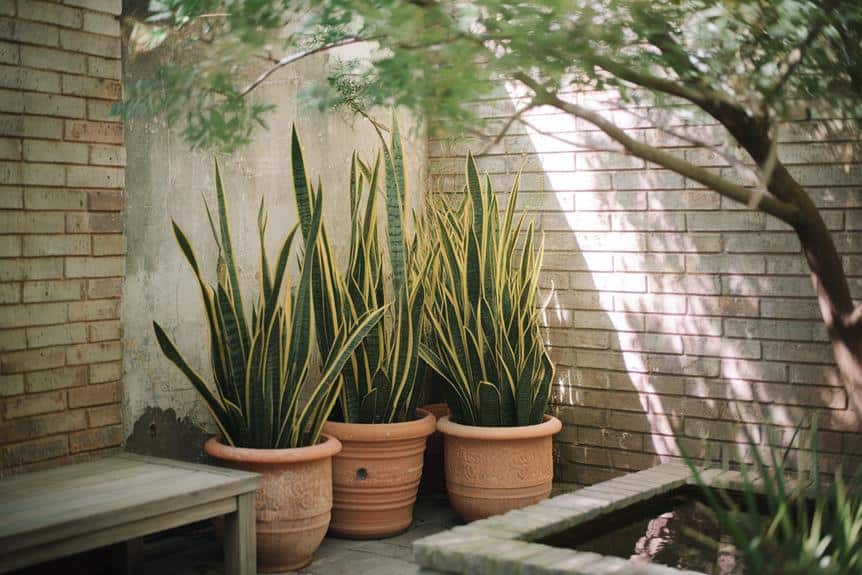
When it comes to choosing suitable outdoor locations for snake plants, you’ll need to examine several key factors. First, consider the amount of sunlight the area receives. Snake plants thrive in partial shade to full sun, so select a spot that offers filtered light or morning sun with afternoon shade. Guarantee the location has well-draining soil to prevent root rot, which can be fatal to these plants.
Next, assess the area’s exposure to wind and foot traffic. Choose a sheltered spot to protect the plants from strong gusts and accidental damage. If you’re creating a garden to serve others, consider accessibility for visitors with mobility issues. Place the snake plants near paths or seating areas where people can easily appreciate their striking appearance. Finally, group snake plants with other drought-tolerant species to create a low-maintenance, water-wise garden that benefits your community.
Container Gardening With Snake Plants
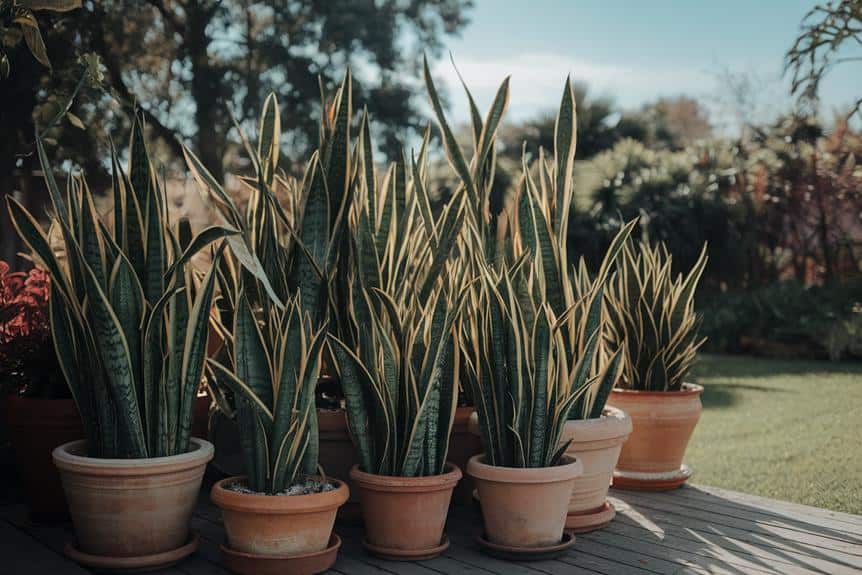
Container gardening enthusiasts will find snake plants to be ideal candidates for outdoor potted arrangements. These hardy plants thrive in various container sizes, from small tabletop pots to large statement planters. When selecting containers, make certain they have adequate drainage holes to prevent root rot. Choose pots that complement your outdoor décor while providing enough space for the plant’s root system to grow.
For a striking display, mix snake plants with other drought-tolerant species in a large container. You’ll create a low-maintenance, eye-catching focal point for your patio or balcony. Remember to use well-draining potting soil and position the containers in areas that receive partial to full sun. During hot summer months, you may need to water your potted snake plants more frequently than their in-ground counterparts. By incorporating snake plants into your outdoor container garden, you’ll add texture, interest, and air-purifying benefits to your space.
Creating Striking Vertical Displays
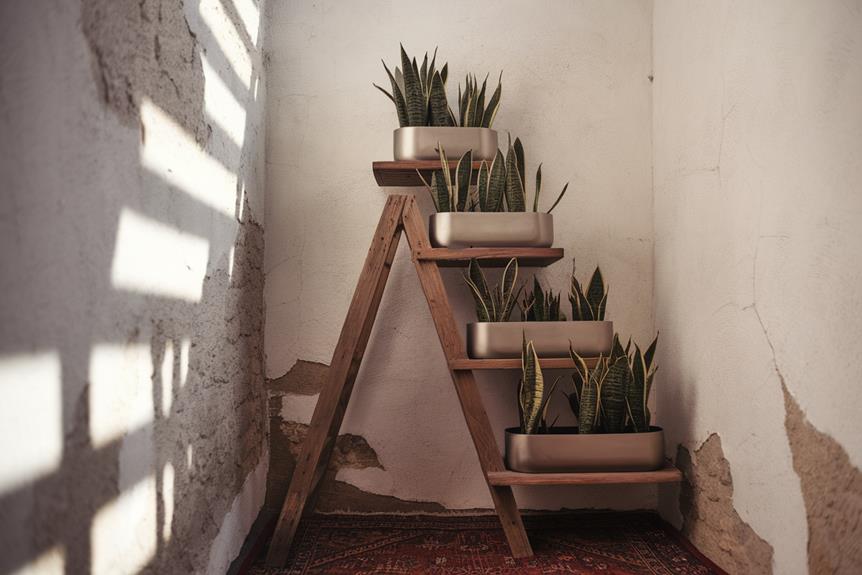
Vertical displays with snake plants can transform your outdoor space into a stunning green oasis. To create eye-catching vertical arrangements, consider using wall-mounted planters or tiered shelving units. These allow you to maximize space while showcasing the architectural beauty of snake plants. For a dramatic effect, mix different varieties of snake plants with varying heights and colors. You can also incorporate hanging baskets or repurpose old ladders as plant stands to add depth and interest to your vertical garden. When designing your display, remember to leave enough space between plants for proper air circulation and growth. To serve others, consider creating a vertical snake plant garden in community spaces or offering to help neighbors set up their own displays. This will beautify shared areas and spread the joy of gardening.
Companion Planting for Snake Plants
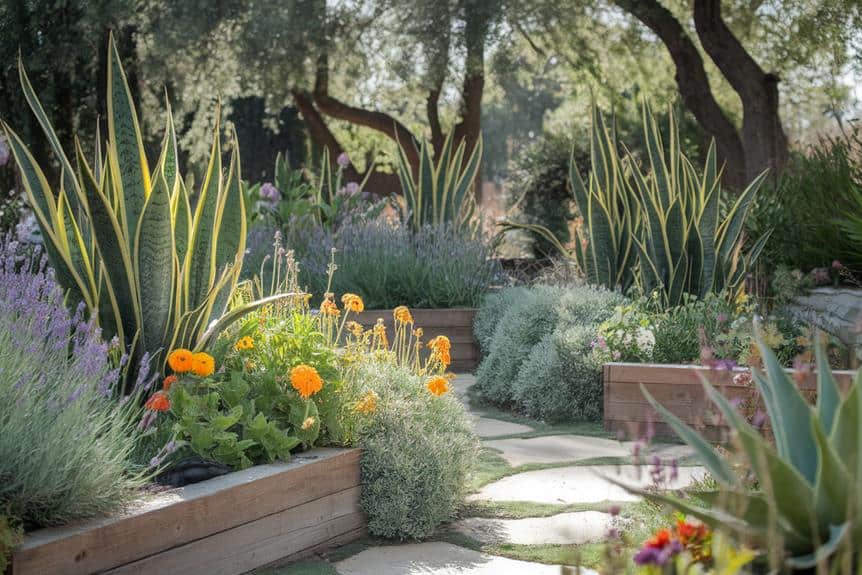
Companion planting can enhance the beauty and health of your outdoor snake plant garden. Consider pairing your snake plants with succulents like sedums or echeverias, which share similar light and water requirements. These low-maintenance companions create an attractive contrast in texture and form.
For a more diverse garden, combine snake plants with drought-tolerant herbs like rosemary or lavender. These aromatic plants not only look great but also repel pests naturally. If you’re looking to add color, consider planting drought-resistant flowering perennials such as black-eyed susans or coneflowers nearby.
To create a layered look, incorporate shorter ground covers like creeping thyme or ice plant around the base of your snake plants. These spreaders will help suppress weeds and retain soil moisture. Remember to choose plants with similar care needs to guarantee a thriving, harmonious garden that serves both aesthetic and practical purposes.
Maintenance Tips for Outdoor Success
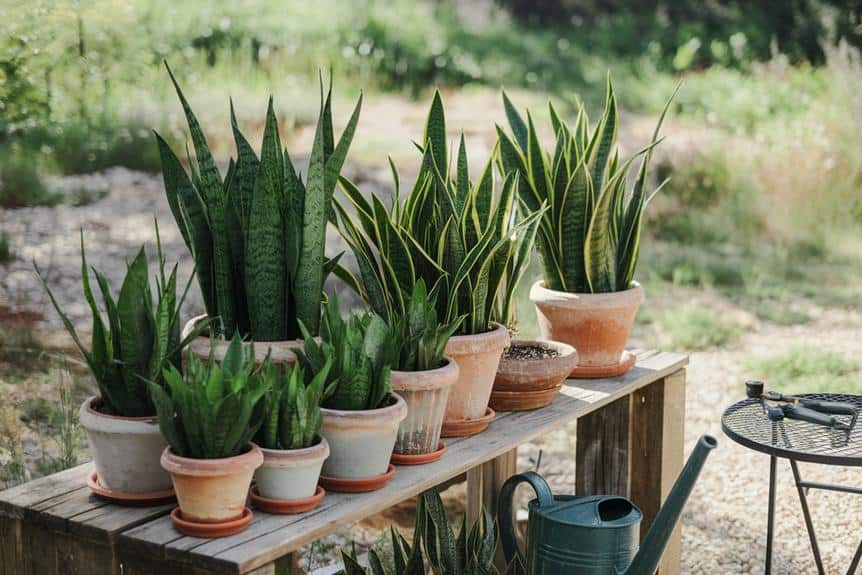
Maintaining your outdoor snake plant garden doesn’t have to be a challenging task. Focus on providing well-draining soil and protecting your plants from excessive moisture. Water sparingly, allowing the soil to dry between waterings. During winter, reduce watering frequency to prevent root rot. Prune any damaged or yellowing leaves to encourage healthy growth and maintain the garden’s appearance.
Monitor your snake plants for pests like spider mites or mealybugs, treating infestations promptly with neem oil or insecticidal soap. Fertilize sparingly during the growing season using a balanced, water-soluble fertilizer. In colder climates, consider bringing your snake plants indoors or providing protective covers when temperatures drop below 50°F (10°C). Regularly remove debris and fallen leaves to prevent fungal growth and maintain a tidy garden. With these simple maintenance tips, you’ll guarantee your outdoor snake plant garden thrives and continues to serve as a beautiful, low-maintenance landscape feature.
